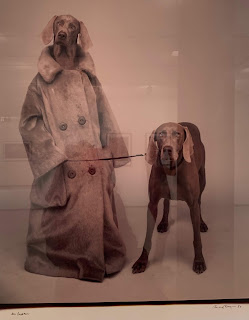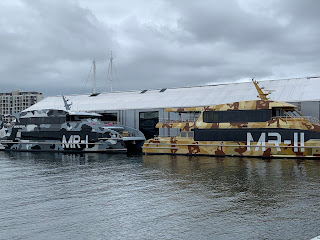Sunday March 10 started a bit cloudy and breezy and it rained for about 15 minutes mid afternoon. It then cleared and there was blue sky and lots of sun. High of 25C.
We started our day with a coffee at Tulip Coffee, a small coffee kiosk on Degraves Street laneway. They roast their own coffee in a nearby suburb. They use one type of bean for their "black coffees", including espressos (known as short blacks here) and another for their "white coffees" (coffees with milk like flat whites). There is a lot of good coffee in Melbourne and the scene is highly competitive.
 |
| Alain with his flat white |
 |
| Tulip coffee |
We then walked up to the Queen Victoria Market. We found out the market is not named after Queen Victoria but instead got its name from its location on the corner of Queen and Victoria streets. There were more people and more fruit and vegetable stalls for the Sunday market which runs from
9:00 a.m to 4:00 p.m. The fish store we went to earlier in the week was one of the few closed on Sunday. However, there were lots of other very good stalls to choose from.
 |
| We bought our fish here |
 |
| Crowd in the fruit and veg section |
 |
| Another great deli |
 |
| The Deli section was our favourite |
 |
| Aussie Deli with all sorts of Aussie meats |
 |
| Sugarcane drinks |
We bought two different kinds of fish and some fruit and vegetables for a few dinners. We then walked back to the apartment and unpacked our purchases. We headed to the Sunday craft market which operates at the Arts Centre. As we headed there, it began to rain. Luckily, most of the vendors were in covered areas.
 |
| Sunday craft market at Arts Centre |
 |
| Lots of folk out |
 |
| I bought a pair of handpainted short socks (not shown here) |
We went back to the National Gallery of Victoria (NGV) to see a few exhibits we had missed on Saturday. The first was called:
Liquid Light: 500 Years of Venetian Glass. The exhibit was shown in the Gallery's Decorative Arts Passage in a series of dark vitrines. It featured Venetian glass from the Gallery's extensive Collection ranging in date from the 16th to the 20th century.
Cristallo, as the Venetians referred to it, was prized throughout Europe for its unsurpassed technical facility and transparent fineness. Interestingly, a large group of Venetian glass entered the Gallery's Collection from purchases of the Italian displays at the 1880-81 Melbourne International Exhibition. There were also some contemporary glass items in an adjoining room.
 |
Oiva Toikka designer (Finland, b. 1931). Pino Signoretto manufacturer, Italy 1994-2017
Kosketus 2014 |
 |
Richard Marquis manufacturer American b. 1945. Murrini on white ground bulbous teapot 1974
Marquis is one of the world's leading practitioners of the murine (mosaic technique) |
 |
| The 19th century revival and later inspirations. |
 |
| Bowl c. 1736 |
 |
| Venice and Murano Glass and Mosaic Company, Venice manufacturer, Italy established 1859. Candelabrum c. 1880 |
 |
| Chalice and cover c 1867-- exhibited at the Paris 1867 Exposition |
 |
| Jug c. 1878 |
 |
| Venice and Murano Glass and Mosaic Company c.1880 |
 |
| Italy, Venice manufacturer 1880 |
We also went to see an exhibit called:
Designing Women. The exhibit highlighted the role of female designers as a dynamic and critical force in shaping contemporary design culture. The exhibit spanned the period from 1980-2018. From fashion design, contemporary jewellery, product design, architecture and digital innovation, the exhibit drew from the NGV Collection to showcase more than 50 significant works.
 |
| Paulina Olowska, Poland (b. 1976) The Painter 2016 . "This painting is part of a recent series of paintings called Wisteria, Mysteria, Hysteria, which combines portraits of women from gardening magazines with elements from Slavic mythology and folklore, as well as techniques from Les Nabis- artists who left Paris to live in the countryside in the 1890s". |
 |
Linda Jackson, Australian fashion designer b. 1950 and Josette Orsto (batik artist, b. 1962)
Tiwi outfit |
 |
| Maree Clarke (b. 1961) 2018 Melbourne |
 |
Mari Funaki (Japan 1950- Australia 2010)
Clip Brooch 2000 |
 |
| Iris van Herpen, The Netherlands (b. 1984) Dress 2011 |
The last exhibit we saw was:
William Wegman: Being Human. Wegman (b. 1943) is an American artist best known for his compositions involving dogs, primarily his own Weimaraners in various costumes and poses. When a Weimaraner joined the artist's family in 1970 and showed an aptitude for performance before the camera, Wegman had found his muse. The dog was named Man Ray, in honour of one of Wegman's favourite modern artists. In 1982, Man Ray died and was named "Man of the Year" by the Village Voice. It was not until 1986 that Wegman got a new dog, Fay Ray, and another collaboration began. His cast grew with Fay's offspring and later their offspring.
Wegman's choice of sets, costumes and props reveal a fascination with art history-Cubism, colour field painting, Abstract Expressionism etc. The show was a lot of fun. Unfortunately, it was very difficult to take pictures as the glass was highly reflective. I found a few images from the internet, which I will identify.
 |
| Sign with video of some of the photographs -- Ocean View 1993 |
 |
| Contact 2014 |
 |
| Dog Walker 1990 |
 |
| On base 2007 |
 |
| Casual 2002 (from Internet) |
 |
| Tamino with Magic Flute 1996 (from Internet) |
 |
| Madame Butterfly 1997 (from Internet) |
 |
| Alain with Dressed to boots 1996 |
When we left the gallery at 5:00 p.m. (closing time), the sun had come out and any humidity had gone. Blue sky. We decided to go for a walk along the Yarra River.
 |
| Leaving the gallery--- waterfall at the entrance |
 |
| The Eiffel Tower on the tutu -- part of the arts centre |
We stopped for a dairy-free treat.
 |
| Second one in the pictures was dairy free |
 |
| View back at the downtown |
There were lots of people walking along the waterfront and eating in the many restaurants and bars along the way. We hadn't realised the area was so developed. Everyone seemed to be out late Sunday afternoon. Australians eat early, so people were already having dinner at around
5:30- 6:00 p.m.
 |
| The Southgate area |
 |
| My favourite- the Eureka building in the background |
 |
| One of the bridges with a bar in the middle |
 |
Another pic of the Eureka bldg.
We decided to walked across a bridge with a number of sculptures on it. The Sandridge Bridge was originally opened in 1888 as a railway bridge. It was closed to rail traffic in 1987 and reopened in its current form in 2006. The sculptures on or near the bridge are called The Travellers.
|
 |
| Gayip- the Aboriginal Period |
Other sculpture along the bridge were
Settler (the convict period 1788-1868);
Melbourne Beauty (the gold rushes 1850-1890);
Walker & His Tucker Bag (assisted migration 1830-1930);
Shelter (displaced persons 1947-1953);
Urban Wheel (European migration 1947-1983);
Running Couple (Refugees 1956-2005);
Butterfly Girl (Asian and Middle East migration (1975-2005);
Tehnoman (students and professionals 1975-2000); and
Walking Sun (Australian multiculturalism).
Australians' History was launched on March 12, 2006 and is a tribute to multicultural Victoria.
 |
| There were 128 glass panels detailing the number of immigrants from countries all over the world-- it was hard to take pics-- this panel detailed migration from Scotland. |
 |
| Running Couple |
 |
| Photo of us with the Melbourne skyline |
 |
| There are lots of cranes in the downtown and lots of new buildings going up |
We walked back to the apartment where Alain made a lovely pasta dinner with duck sausage and we finished the rest of our wine.


















































Comments
Post a Comment